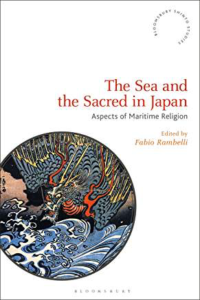 The Sea and The Sacred in Japan: Aspects of Maritime Religion (Bloomsbury Shinto Studies), ed. Fabio Rambelli. Bloomsbury Academic, 2018. 296 pages.
The Sea and The Sacred in Japan: Aspects of Maritime Religion (Bloomsbury Shinto Studies), ed. Fabio Rambelli. Bloomsbury Academic, 2018. 296 pages.
By Dr. Michelle Damian (Monmouth College)
This volume is a very welcome addition to the body of English-language literature on maritime perspectives of Japanese history. Editor Fabio Rambelli brings together a wide range of scholars from Japan, Europe, and the United States, all of whom reconsider religious discourse in the premodern era from the perspective of the sea. This is no minor rethinking. As many of the authors point out, premodern Japanese perspectives generally privileged the land. Mountains were seen as religious centers, and court aristocrats (who authored many of the documents that survive to the present day) viewed the sea as terrifying. Rambelli and others point out historian Amino Yoshihiko’s influence and his focus on marginalized groups such as “sea people” (not just sailors, but fisherpeople, salt makers, and others who earned their livelihoods from the sea), and acknowledge the impact that folklorists such as Yanagita Kunio and Orikuchi Shinobu had on considerations of the sea’s impact. This group of scholars collectively asks what happens if we reevaluate premodern Japanese myths, rituals, deities, and practices by putting the sea first. The questions this approach poses offer fascinating new ways to consider Japanese history, and open up new lines of inquiry for future research.
The book is divided into four sections: Ancient Sea Myths and Rituals and their Reinterpretations, Sea Deities and Sea Cults, Buddhism and Japan in the Global Ocean, and Interpretive Constructs. Space limitations prevent a thorough discussion of the individual chapters here, but many of the authors focus on close, comparative readings of numerous texts. They consider both the influence of the sea on the development of religious thought and myths, and external influences that affected portrayals of the sea in those tales. As just one example, several authors trace the changing role of the sea, first viewed as a frightening place that is the “land of the dark” in early texts, to its later perception as a source of blessings and bounty – not coincidentally, some aspects of this change coincide with the development of a more robust maritime trade. Recurring questions include the origins of sea deities and sea cults, the fluid nature of maritime identity, gender roles in seafaring and worship, and Japan’s position within the maritime boundaries of East Asia.
Specialists in premodern Japan and/or Japanese religious history will most appreciate this volume. An unavoidable challenge with this type of topic is translation of specific mytho-religious terms, and many of the authors choose to use the original Japanese words throughout their papers. While understandable, as accurate translations of those terms can become cumbersome, it poses more of a challenge for a casual reader. The authors sometimes assume that the reader has a familiarity with the sociopolitical context of the times that may make it more difficult for a nonspecialist audience.
There is some overlap within the individual chapters as the authors introduce the original myths, documents, and concepts that they are studying. This speaks to the originality of their lines of inquiry; until now, there has been no common English-language work to consult that references or introduces maritime religions of Japan. As I read through the articles I could not help but envision how exciting it would be to gather these scholars in the same room and listen to the ensuing conversation as they developed their ideas and explored common or contrasting perspectives on their topics. That is perhaps the most stimulating aspect of this book: the promise of additional, ongoing research on this sorely understudied topic.






